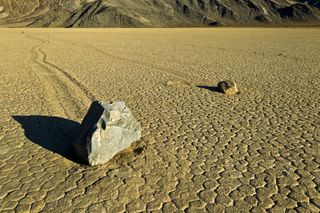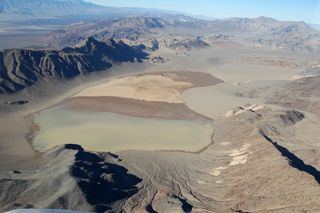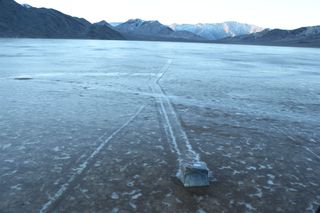High-Tech Sleuthing Cracks Mystery of Death Valley's Moving Rocks

The first witnesses to an enduring natural mystery are an engineer, a biologist and a planetary scientist who met thanks to a remote weather station.
This odd group has captured the first video footage of Death Valley's sailing stones creeping across Racetrack Playa. For a century, these eerie rocks and their long, graceful trails have stumped visitors and scientists. The boulders of black dolomite appear to move on their own, sliding uphill across the playa's flat lakebed. The trails are the only evidence the rocks move. No one has ever seen them set sail. [Video: Sailing Stones of Death Valley Seen in Action]
Lacking direct evidence, explanations for this geologic puzzle ran the gamut, from Earth's magnetic field to gale-force winds to slippery algae. Now, with video, time-lapse photographs and GPS tracking of Racetrack Playa's moving rocks, the mystery has finally been solved.
Jagged plates of thin ice, resembling panels of broken glass, bulldoze the rocks across the flooded playa, the scientists reveal today (Aug. 27) in the journal PLOS One. Driven by gentle winds, the rocks seem to hydroplane atop the fluffy, wet mud.
"It's a wonderful Goldilocks phenomenon," said lead study author Richard Norris. "Ponds like this are vanishingly rare in Death Valley, and it may be a decade between heavy enough rain or snowfall events to make a substantial pond," said Norris, a paleobiologist at the Scripps Institution of Oceanography in San Diego, California.
One-in-a-million mystery
Leading theories had already narrowed in on wind, water and ice to propel the playa's rocks. But no one has come up with thin ice before. Models always targeted thick ice sheets, which could float the rocks across the playa like wind-driven icebergs. The ice seen during the study is too thin to pick up anything but pebbles.
Sign up for the Live Science daily newsletter now
Get the world’s most fascinating discoveries delivered straight to your inbox.
"I have to confess I was surprised," said study co-author Ralph Lorenz, who has authored several studies suggesting thick ice carries the playa rocks. "I really expected buoyancy to be required, and it clearly wasn't. The ice was thinner than I thought would be needed. It was amazing to see the process actually happen," said Lorenz, a planetary scientist at the Applied Physics Laboratory at Johns Hopkins University in Baltimore.
A similar phenomenon is at work in colder climates, on a much more massive scale, the researchers said. When frozen lakes and rivers break up in the spring, the ice floes can dislodge big boulders, leaving grooves in the muddy sediment.
In a terrain known for its barren and bizarre geology, Racetrack Playa is one of the strangest. The dry lake is 3 miles long (4.5 kilometers), nearly flat as a tabletop and littered with a few hundred rocks. Some are as small as baseballs, but other boulders weigh as much as 700 lbs. (317 kilograms). Even the largest rocks trail long furrows behind them. [Image Gallery: How Ice Drives Death Valley's Sailing Stones]
Some trails are short; some stretch twice the length of a football field. Other trails sharply zig and zag, suggesting quick changes in direction. Mysteriously, some trails are missing rocks.
The playa occasionally floods in winter, from rain or melted snow. Sitting at 3,608 feet (1,100 meters) above sea level and ringed by mountains, nighttime temperatures can drop below freezing, sheeting the temporary lake in thin ice or freezing it solid.
A rare combination of water and ice combines to move the rocks, the researchers said. The playa lake needs to be deep enough for floating ice, but shallow enough to leave the rocks exposed. The surface ice should be thin "windowpane" ice, but strong enough to break into big panels that can bully the rocks. Finally, the freezing nights need to be followed by sunny days with light winds, which drive the cracking ice across the lake.

A series of wet winter storms created the perfect conditions from December 2013 through February 2014. Hundreds of rocks scooted across Racetrack Playa five times in 10 weeks.
"Basically, the rocks move for about one minute in a million minutes," Lorenz told Live Science. "You have to be there at the right time, and the right time is generally one of the least hospitable times to be there."
Playa passion
Reaching Racetrack Playa requires a bone-jarring ride down a 28-mile gravel road. The remoteness has never deterred anyone obsessed with solving the riddle of the rocks. The first experiments here started in the 1940s and have never stopped. [Hell on Earth: Image Tour of Death Valley]
A few years ago, two California cousins who grew up with a love of the desert decided to tackle the Racetrack Playa problem. Richard Norris is the biologist and Jim Norris is the engineer. They nabbed rare National Park Service permits to install equipment and sensors in Racetrack Playa.
"It's almost the purest form of doing science, for discovery's sake, rather than because your reputation is tied up in it," Richard Norris said.
In the winter of 2011, with the help of family and friends, the Norris clan lugged 15 imported rocks with motion-activated GPS units built by Jim Norris onto Racetrack Playa. (The Park Service didn't want the natural rocks disturbed.) They also installed a weather station to track wind gusts.
They waited for the rocks to move, but there was never any water.
Two years later, Lorenz, the planetary scientist, saw the weather station and tracked down the team at a research meeting held in Death Valley in November 2013. The Norris group was easy to find — they had matching T-shirts blazed with "Slithering Stones Research Initiative." Over beers, the researchers decided to join forces.
Lorenz has been investigating the sailing stones since 2006. He came to Death Valley to study the dust devils as an analog for conditions on Mars, but he also became fascinated by Racetrack Playa.
Right place, right time
In December 2013, the team hit the jackpot. They discovered the playa was slicked with water three inches (7 cm) deep. Overnight, the pond froze and when the sun rose the next morning and cracked the ice, the rocks set sail. It was all caught on camera.
Hundreds of rocks were in motion, Norris said. "The ice was just crackling and popping and making all these noises across the playa."

Some rocks moved in concert, even though they were hundreds of feet apart, while others creeped independently. The rocks crept along at a few inches per second (2 to 6 meters per minute), pushed by winds at about 10 mph (16 km/h). The creeping could barely be detected at a distance. [World's Most Famous Rocks]
Rocks traveled more than 200 feet (60 m) and remained in motion for a few seconds to 16 minutes. They would often move more than once before reaching their final resting place. By itself, the ice carved furrows that resemble the rockless trails. The remains were blown up into shattered piles on the playa's far shore.
Finding themselves at the end of an enigma, both Norris and Lorenz said they were convinced the detective work wasn't over yet. For instance, no one ever saw the gigantic playa boulders budge an inch, so another process may be at work on the biggest rocks.
"I know there are people who like the mystery of it and will probably be somewhat disappointed that we've solved it," Norris said. "It's a fascinating process, and in many ways I hope that there's more to be discovered. Never say never."
Editor's note: This story was updated to correct the rock and wind speeds.
Email Becky Oskin or follow her @beckyoskin. Follow us @livescience, Facebook & Google+. Original article on Live Science.

Most Popular


